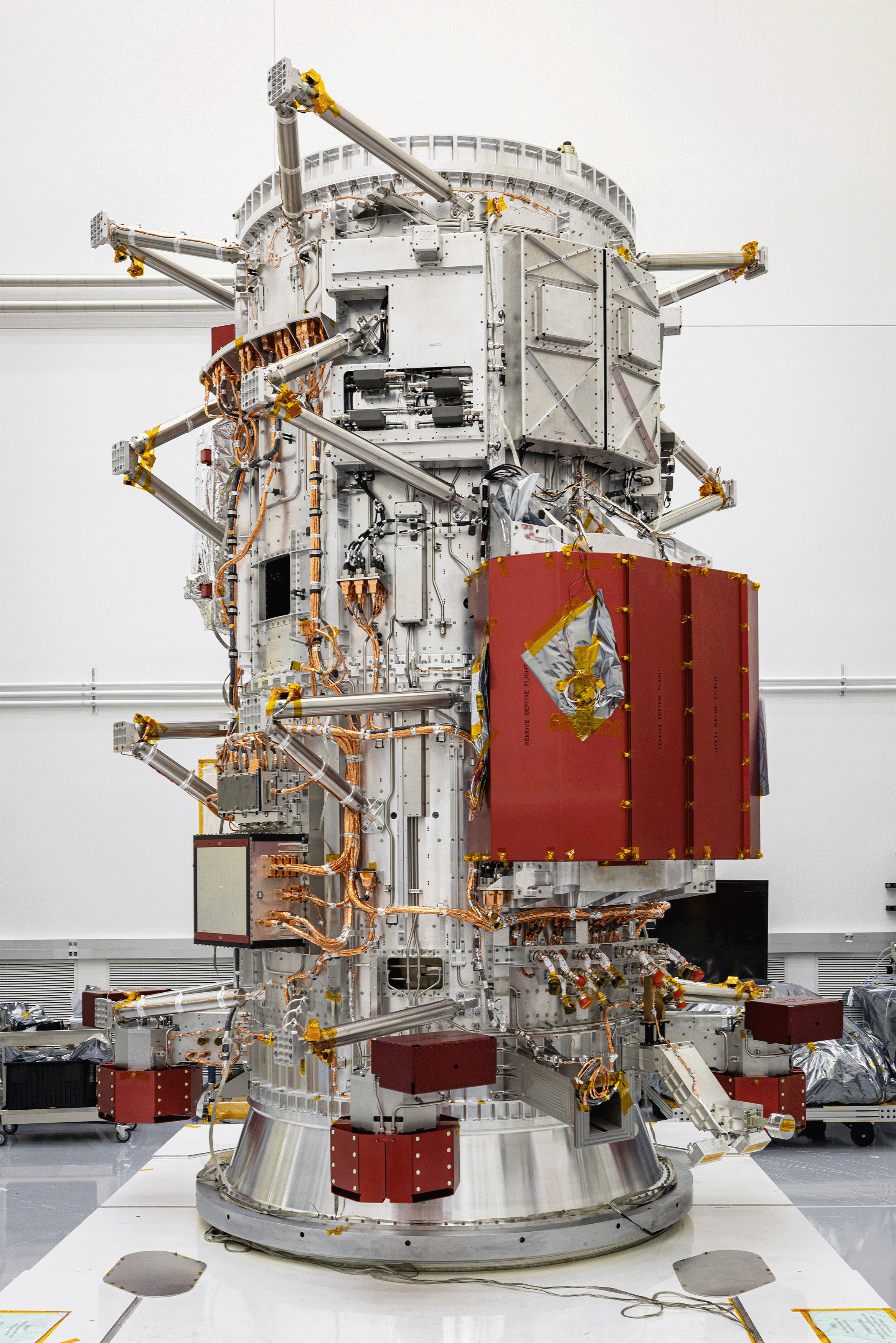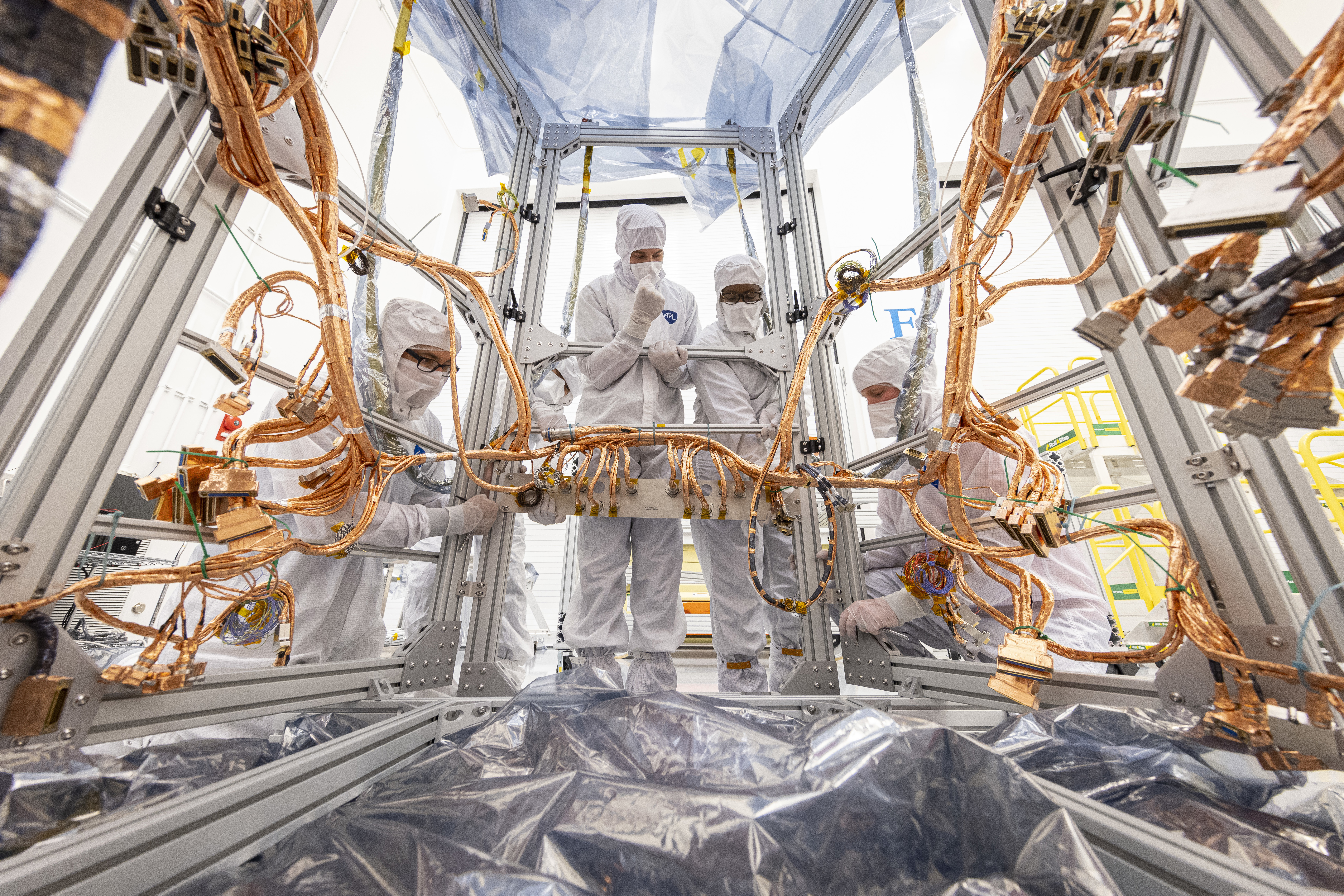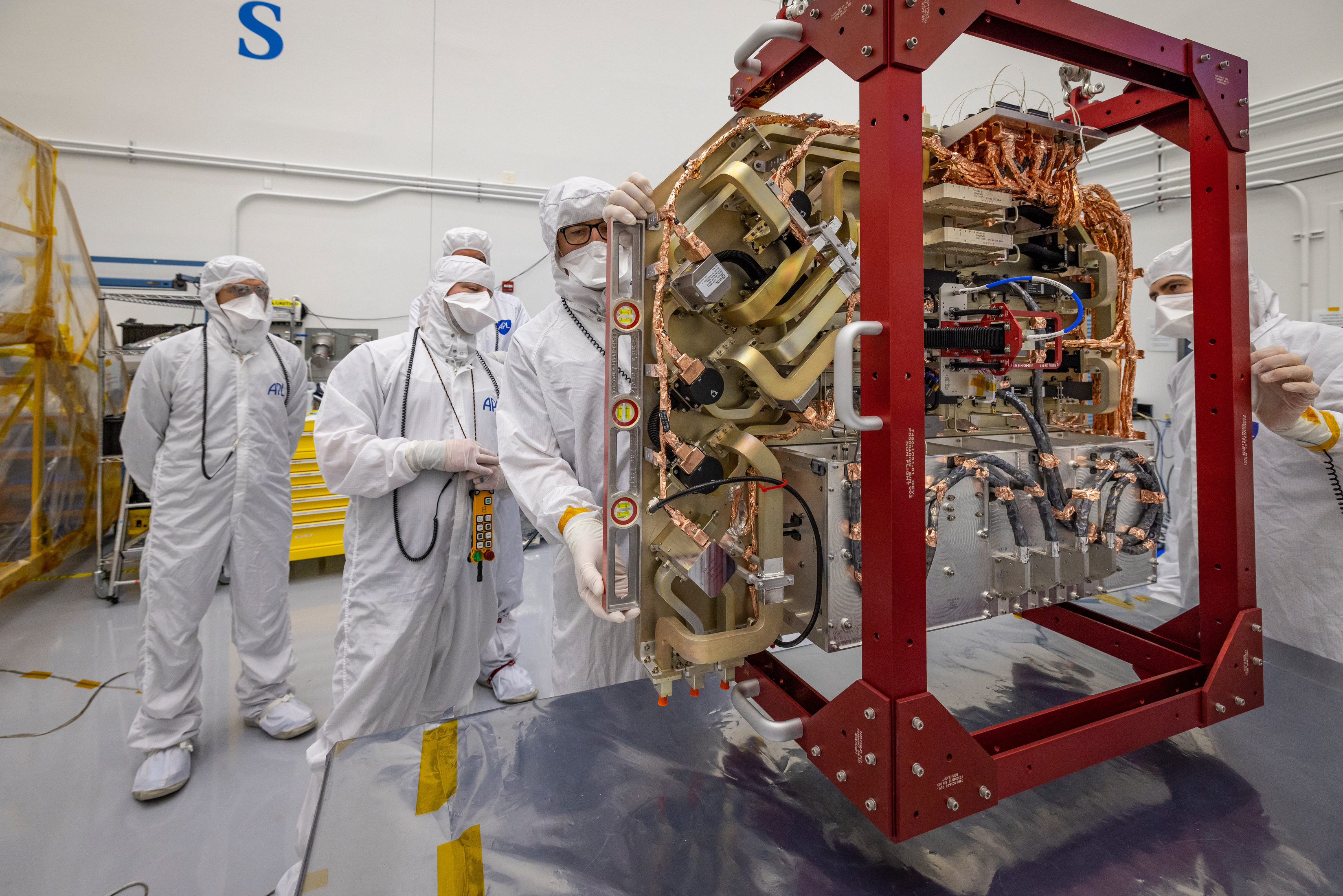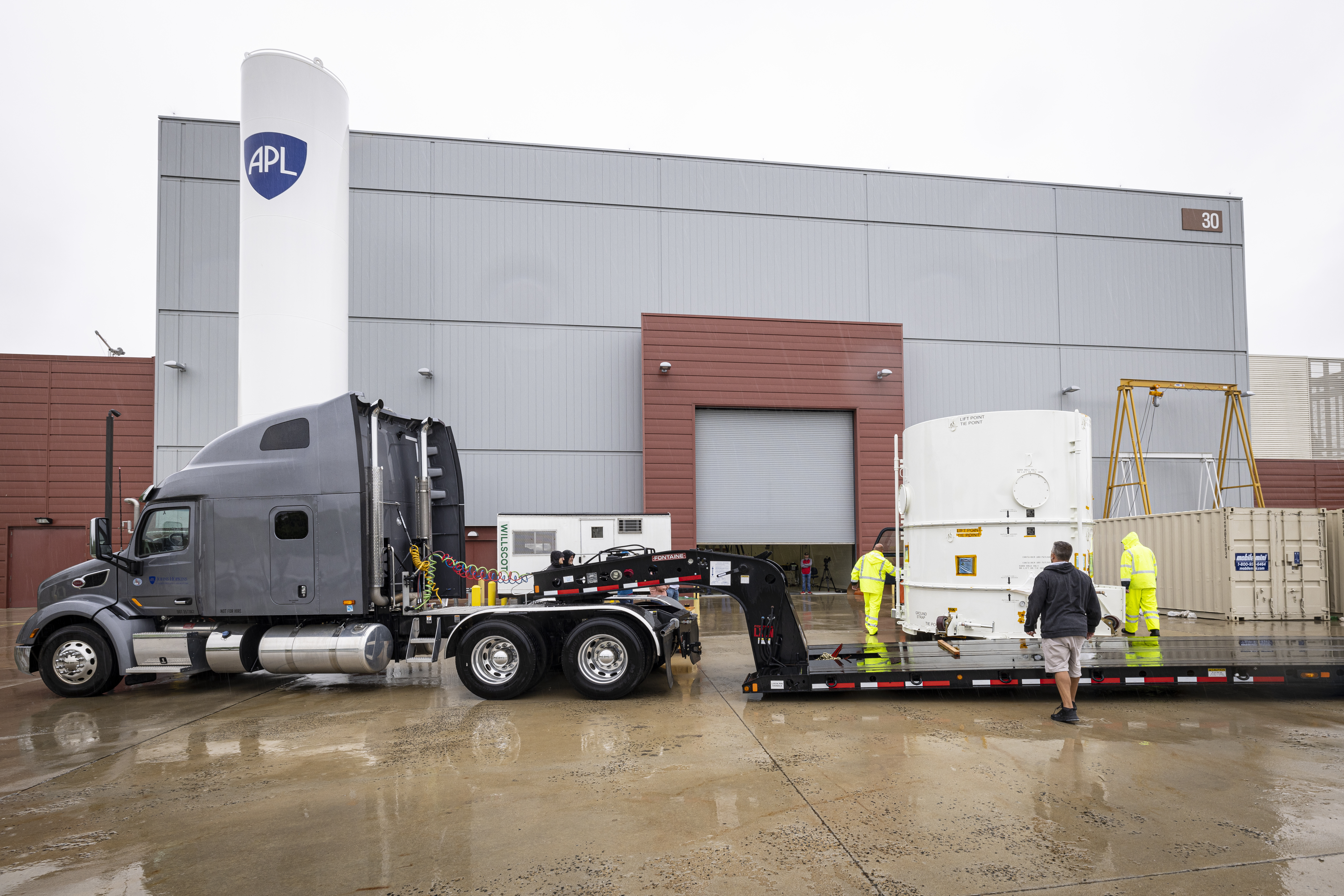After nearly 12 years of design iterations and construction, two trips across the country and thousands of hours of labor, NASA’s Europa Clipper propulsion module — the spacecraft’s “workhorse” — and its radio frequency (RF) module are complete and ready for integration with the remainder of the spacecraft.

Designed by the Johns Hopkins Applied Physics Laboratory (APL) in Laurel, Maryland, and built in collaboration with NASA’s Jet Propulsion Laboratory (JPL) in Pasadena, California, and NASA’s Goddard Space Flight Center in Greenbelt, Maryland, the completed modules were shipped May 31 from Joint Base Andrews in Maryland to JPL. The delivery marks a major milestone for the team developing the largest spacecraft ever for a NASA planetary mission.
“It’s bittersweet to ship out these parts,” said Stuart Hill, an APL mechanical engineer and the product delivery manager for Europa Clipper’s propulsion module. “I’m really proud of the hardware we’ve developed, but even more so, I’m very proud of the team and how everyone has performed together over these many years.”
Set to launch in October 2024, Europa Clipper will perform nearly 50 flybys of Jupiter’s moon Europa, which almost certainly has a liquid water ocean beneath its icy surface due to the tidal heating exerted by its gas giant neighbor. In fact, Europa may contain all the ingredients needed for life to exist. Europa Clipper is going to find out whether Europa could harbor conditions suitable for life.
At about 10 feet (3 meters) tall and 5 feet (1.5 meters) in diameter, Europa Clipper’s propulsion module comprises about two-thirds of the spacecraft’s main body. It’s effectively the backbone, carrying its own electronics system and thermal control.
The structure consists of two stacked aluminum cylinders, each made of about 1,000 6-to-9-inch-tall (15-to-23-centimeter-tall) rings that APL engineers manufactured and riveted together. Hundreds of threaded holes dot the module, providing grasp points for the nuts and bolts that will mount the component’s cargo: the RF module, radiation monitors, propulsion electronics, multiple instruments, a diode box, power converters, hundreds of yards of wiring and thermal elements that will keep the structure’s temperature stable while in space.
“Physically, it’s the largest system we’ve ever built at APL,” said Tom Magner, APL’s Europa Clipper project manager.
The enormity of the structure mirrors its monumental purpose: getting Europa Clipper into orbit around Jupiter. After nearly six years of space travel and using Mars’ and Earth’s gravity to propel it to the outer solar system, Europa Clipper will come hurtling in toward Jupiter so fast that it will swing right around the gas giant and continue out to deep space if it doesn’t slow down on approach.

To achieve the necessary change in velocity, the propulsion module carries nearly 6,000 pounds (2,750 kilograms) of monomethyl hydrazine and dinitrogen tetroxide (or MMH/NTO) propellant, which an array of 3-to-4-inch-wide (7-to-10-centimeter-wide) engines will burn.
“When you see them next to this gigantic spacecraft, you think, ‘They just don’t seem big enough!’” Hill said. “They’re like the little engines that could.”
The propulsion module has a total of 24 engines, of which only 16 are aft facing. And because the module has a primary side and a backup side, only eight of the aft-facing engines will fire at any one time.
Consequently, the engines will have to burn for 6-8 hours to slow the spacecraft to orbital capture velocity, using between 50% and 60% of the propellant. But this strategy, Hill said, avoids the risks of using big engines, which need extra protection from potential micrometeorite impacts. Many smaller engines can accomplish the same task while guaranteeing many backups if one engine malfunctions or is damaged by a micrometeorite.
A MAZE OF CIRCUITRY
Powering a system as large as the propulsion module and its payload requires a web of electrical wires and circuitry. This electrical labyrinth is called the harness, and much like the rest of the system, team members could only describe this harness with one word: “massive.”
“It’s one of the biggest harnesses APL has ever built,” Hill said.
Weighing about 150 pounds (68 kilograms), the harness contains thousands of electrical wires and connectors that if placed end to end would stretch almost 2,100 feet (640 meters) — enough to wrap around the perimeter of a football field twice.
Carlisa Drew, the lead harness technician, pieced the entire harness together by hand. An electrician by trade, she was used to building simple single cables, and the harness, she said, was more or less just many (many) single cables strung together.
“In the beginning, I felt pretty confident,” she said, chuckling. “So they handed me the plans and then cut me loose.”
The task was much larger than she had imagined. She and several colleagues spent about a year assembling the harness on a mock-up propulsion module, roping wires together, attaching pins to the ends of the wires and inserting the pins into connectors. They had wrapping parties where they’d cover connectors with as many as 18 layers of sheeted copper or lead to protect them from Jupiter’s harsh radiation environment.

“The amazing part of this effort is the people who designed the system,” she said. “Having wires all run in every direction to the different components — it’s a remarkable feat.”
In its final position, the harness’ trunk climbs the spine of the propulsion module like a central nervous system, sending out branches of electrical wires around the cylindrical frame. Those branches power the module’s various parts, including a diode box that allows the module’s two sides to control each other if necessary; a thermal component to ensure the propulsion module and its propellant stay at near-constant temperature; and gimbals that will allow the spacecraft’s massive solar arrays to rotate as needed.
“I’m speechless sometimes,” Drew said. “It’s the coolest thing I’ve ever done.”
CLUSTERS OF COMMUNICATIONS
Mounted near the top of the propulsion module is the spacecraft’s RF panel, a component of the much larger RF module that houses the spacecraft’s telecommunications subsystem as well as mechanical, thermal and harness components to support it.
Designed and built by APL, and with a large high-gain antenna supplied by aerospace vendor Applied Aerospace Structures Corporation (AASC) in Stockton, California, the RF module was a first for APL scientists and engineers, and a tall hurdle to surmount.
“From a mechanical standpoint, the packaging of this was very, very challenging,” said Simmie Berman, the product delivery manager for the RF module at APL.
The RF module contains a dizzying number of components, the majority of them packed into the RF panel’s 4-by-3-foot (1.2-by-0.9-meter) area. The panel houses the RF subsystem electronics and an intricate network of switches, filters and waveguides to carry the RF signal among the electronics and eight antennas around the spacecraft. The panel also holds an RF minivault, which Berman points out is actually fairly large at 2 feet (60 centimeters) long and about 1 foot (30 centimeters) wide. It holds two APL-built Frontier Radios, four power conditioners and two radiation monitors.

Three antenna clusters on the propulsion module and avionics vault also connect to the RF panel, including three low-gain antennas, three fan-beam antennas and a medium-gain antenna. The RF panel will also eventually connect to the spacecraft’s enormous, 10-foot-diameter (3-meter-diameter) high-gain antenna — the device that will enable science data downloads and allow ground controllers to communicate between Earth and the spacecraft while Europa Clipper orbits Jupiter hundreds of millions of miles away.
“The assembly was very well thought out,” Berman said. “The RF module came together really well.”
A small group of around 40 team members traveled from APL with the modules and components to California for the handover to JPL. APL will then assist with the integration and testing of the spacecraft in preparation for launch. In the coming months, APL scientists and engineers on the Europa Clipper team will complete and deliver the two cameras that are part of the Europa Imaging System as well as the Plasma Instrument for Magnetic Sounding that will measure the plasma (or high-energy charged particle) environment around Jupiter and Europa, helping to precisely determine Europa’s ice shell thickness, ocean thickness and ocean conductivity.
Related Topics
For Media Inquiries
For all media inquiries, including permission to use images or video in our gallery, please contact:
Michael Buckley
All Media Resources

